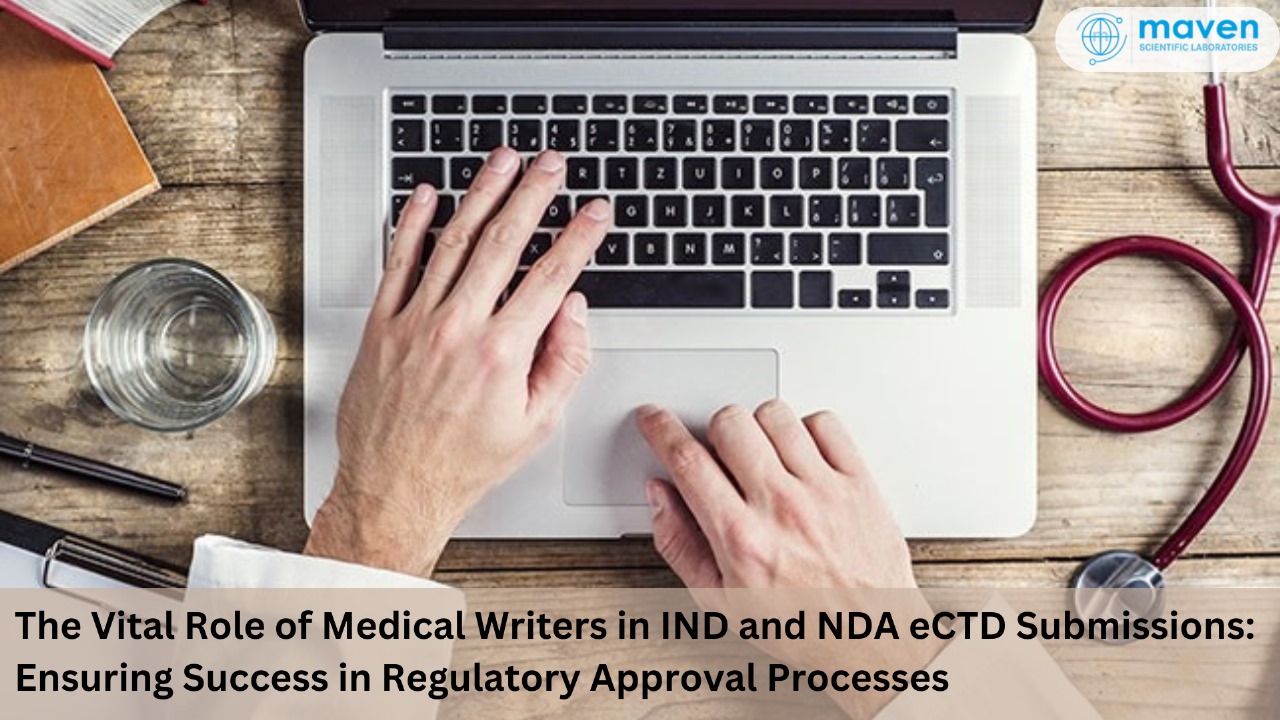
The Vital Role Of Medical Writers In IND And NDA ECTD Submissions: Ensuring Success In Regulatory Approval Processes
In clinical and nonclinical research, the development of high-quality documentation is essential to the timely submission and approval of new drug products. For sponsors preparing to submit an Investigational New Drug (IND) or New Drug Application (NDA) to the U.S. Food and Drug Administration (USFDA), medical writing is a critical function that ensures the comprehensive, organized, and regulatory-ready presentation of all necessary nonclinical, clinical, and scientific data. The process, often intricate, requires meticulous attention to regulatory guidelines, a thorough understanding of the eCTD (Electronic Common Technical Document) specifications, and expert knowledge in summarizing complex data.
Understanding the eCTD Framework for IND/NDA Submissions
The eCTD framework is a standardized, structured format used by regulatory authorities globally, including the USFDA, the European Medicines Agency (EMA), and the Pharmaceuticals and Medical Devices Agency (PMDA) in Japan. It is designed to streamline the submission, review, and life-cycle management of pharmaceutical data for regulatory approvals. The eCTD structure divides submissions into five primary modules:
- Module 1: Region-Specific Administrative Information (specific to the region; not technically part of the CTD)
- Module 2: Common Technical Document Summaries (including overviews and summaries of the quality, nonclinical, and clinical data)
- Module 3: Quality (detailed information on manufacturing, testing, and control of the drug substance and drug product)
- Module 4: Nonclinical Study Reports (covering pharmacology, pharmacokinetics, and toxicology)
- Module 5: Clinical Study Reports (covering clinical trials and studies, including bioavailability and bioequivalence)
Each module plays a pivotal role in ensuring the regulatory authorities receive all necessary data in a format that promotes clarity, consistency, and comprehensive scientific understanding.
Key Modules in IND/NDA Submissions
Medical writers preparing IND/NDA submissions need to have a strong grasp of the following essential modules to achieve a well-structured eCTD submission:
- Module 2.4: Nonclinical Overview – This section summarizes key findings from nonclinical studies, including pharmacology, pharmacokinetics, and toxicology.
- Module 2.5: Clinical Overview – This section provides an overview of the clinical pharmacology, efficacy, and safety data.
- Module 2.6: Nonclinical Summaries (written and tabulated) – Detailed summaries and tabulations of nonclinical studies.
- Module 2.7: Clinical Summaries – Summarizes the clinical efficacy and safety data in a comprehensive format.
- Module 4: Nonclinical Study Reports – Contains complete nonclinical study reports in areas like pharmacology, toxicology, and pharmacokinetics.
- Module 5: Clinical Study Reports – Presents detailed clinical study reports, including bioavailability, bioequivalence, clinical efficacy, and safety data.
The precision, clarity, and organization of information within these modules are vital to prevent errors and rejections, and they underscore the significance of skilled medical writers in this process.
Challenges in Preparing eCTD-Compliant Submissions
Document preparation for IND/NDA submissions is a complex process. Failure to comply with eCTD structure or submission requirements can lead to rework, timeline delays, or, in severe cases, outright rejection by the regulatory body. Some common challenges include:
- Complexity and Volume of Data: The large volume of detailed scientific data requires not only a high level of expertise but also significant time and effort to prepare.
- Regulatory Compliance: Each document must adhere to specific regional regulations and eCTD specifications, which vary across regulatory bodies.
- Data Consistency and Accuracy: The information must be accurate and consistent throughout all documents to avoid discrepancies that could delay the review process.
- Technical Readiness: Submissions must be ready for electronic review; any technical issues or formatting errors can lead to a submission being returned for revision.
A skilled medical writer can mitigate these challenges by ensuring that every document meets eCTD structure and formatting requirements, as well as being scientifically robust and aligned with regulatory expectations.
Why Professional Medical Writers are Essential for IND/NDA Submissions
Medical writers bring not only scientific expertise, but also technical knowledge of the specific regulatory requirements mandated by agencies like the USFDA, EMA, and PMDA. They play an essential role in the IND/NDA submission process by:
- Providing Scientific Accuracy and Consistency: Accurate and consistent data presentation ensures that the regulatory review process proceeds smoothly without errors that could necessitate resubmissions.
- Navigating Regulatory Requirements: Medical writers are well-versed in region-specific guidelines and eCTD requirements, and they can anticipate regulatory expectations and address any nuances.
- Conducting Gap Analyses and Quality Checks: Gap analysis and quality checks identify any missing information or inconsistencies, minimizing potential delays.
- Collaborating with Stakeholders: By working closely with cross-functional teams, medical writers ensure all data are accurately represented and meet regulatory requirements.
Regional Regulatory Bodies and Their Expectations
Medical writers must stay updated on the requirements set by major regulatory bodies to ensure that submissions are compliant. Here’s a look at some of the prominent agencies:
- U.S. Food and Drug Administration (USFDA): The USFDA requires IND/NDA submissions to adhere to eCTD specifications and provide clear, consistent data for regulatory review. Any non-compliance with formatting or data inconsistencies can lead to delays or rejection.
- European Medicines Agency (EMA): The EMA mandates submissions in the eCTD format and has strict guidelines on safety, efficacy, and quality. Medical writers must ensure that the summaries and overviews, particularly in Modules 2 and 3, are concise yet comprehensive.
- Pharmaceuticals and Medical Devices Agency (PMDA) in Japan: Like the USFDA and EMA, the PMDA requires eCTD submissions and expects a high level of detail in Modules 2, 4, and 5. Medical writers working with Japanese submissions need to be especially mindful of regional language and presentation preferences.
- Health Canada: Health Canada also uses eCTD for drug submissions. It expects compliance with specific document standards and regulatory requirements for clinical and nonclinical data.
- Therapeutic Goods Administration (TGA) in Australia: The TGA requires that all drug submissions be in eCTD format, and it emphasizes quality and safety, particularly in the overview and summary modules.
How Maven Medical Writers Assist with eCTD Modules
Maven’s medical writing team has in-depth expertise in developing IND and NDA submission documents that align with eCTD specifications. By leveraging specialized knowledge in Modules 2, 4, and 5, Maven medical writers streamline the document preparation process for regulatory submissions. They ensure all sections are scientifically accurate, formatted correctly, and compliant with regional requirements. Maven’s team also conducts comprehensive gap analyses and quality checks, minimizing the risk of technical rejections and delays. Their proactive approach and technical proficiency allow sponsors to meet regulatory expectations efficiently, supporting an effective and timely submission process.
The Benefits of Partnering with an Expert Medical Writing Service
Given the complexities involved in regulatory submissions, sponsors may benefit significantly from working with experienced medical writing service providers. Such professionals can ensure:
- Streamlined Submission Process: Expert medical writers reduce the burden on sponsors by managing the entire document preparation process, including data organization, consistency checks, and regulatory alignment.
- Reduced Risk of Delays: Compliance with all regulatory guidelines from the outset minimizes the risk of rework and delays, keeping projects on track.
- Cost-Effective Solutions: By entrusting medical writing to experienced professionals, sponsors can avoid costly mistakes and focus resources on other critical areas of drug development.
Conclusion
The success of an IND or NDA submission often hinges on the quality and accuracy of its documentation. With the ever-growing complexity of regulatory requirements and the critical nature of timely submissions, experienced medical writers play an indispensable role in the drug approval process. By providing scientific accuracy, regulatory expertise, and a structured approach to data presentation, medical writing professionals support sponsors in achieving effective and timely submissions, facilitating smoother and more successful regulatory reviews.







